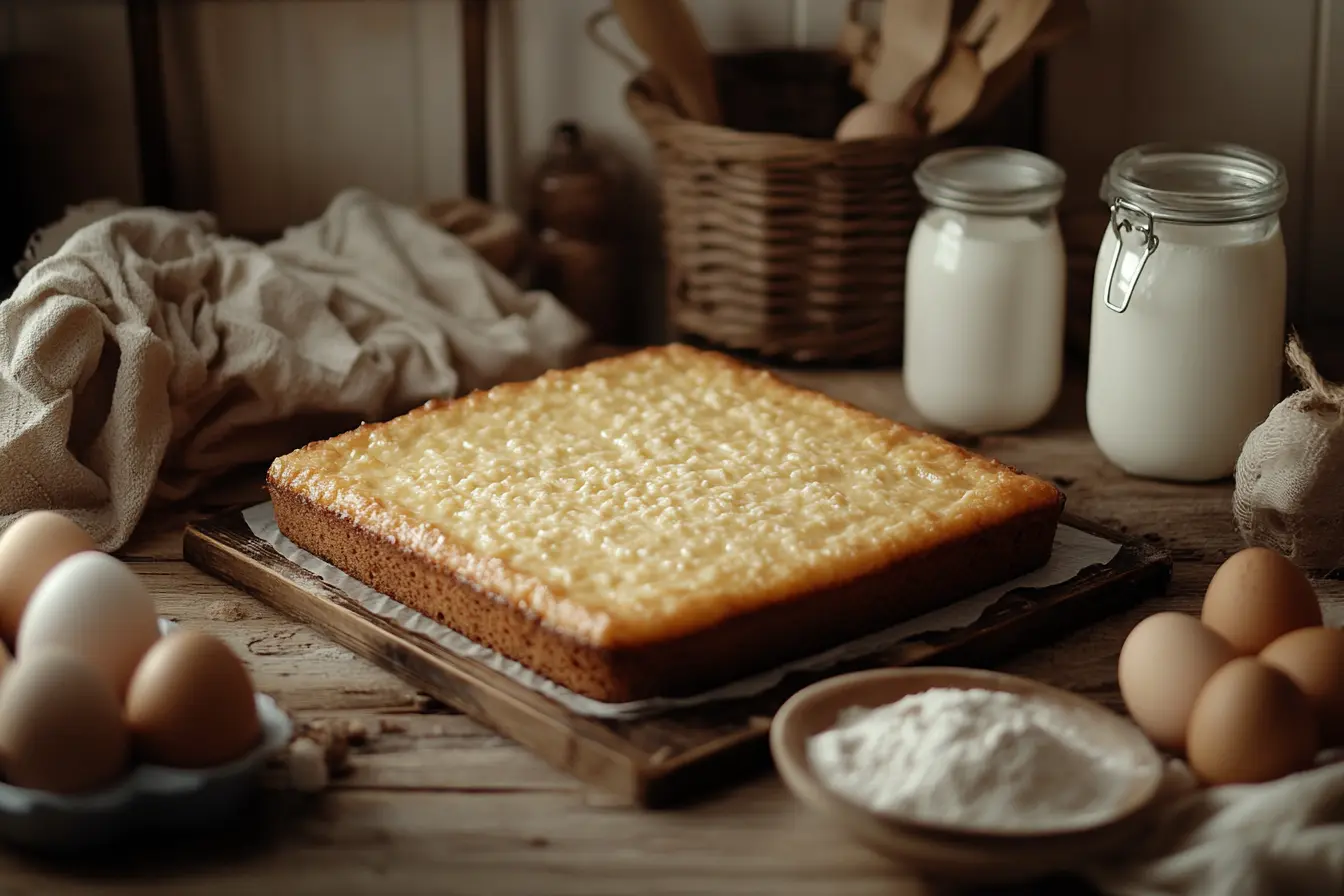Introduction
Baking is an art, but with the right ingredients and method, it can also become a science that promotes wellness and flavor. Enter the kefir sheet cake, a delightful treat enriched with the tangy goodness of probiotic-rich kefir. Not only does this cake offer fantastic taste, but it also boasts incredible texture and numerous health benefits. Moreover, baking it brings the simple yet fulfilling joy that every home baker craves. To help you fully embrace this underrated gem, we will dive deep into its unique flavor profiles. Additionally, we’ll walk you through step-by-step preparation to ensure your success. So, let’s uncover the secrets and charm of this versatile dessert together.
Introduction to Kefir Sheet Cake
Understanding Kefir Sheet Cake
A kefir sheet cake isn’t just another dessert—it’s a blend of tradition, health, and versatility. This cake utilizes kefir, a fermented dairy product with a tangy flavor, as its star ingredient. The result? A moist, tender crumb with a slightly tart kick that stands out from ordinary sheet cakes.
What is Kefir?
Kefir, often referred to as a “superfood,” is a cultured dairy product similar to yogurt but thinner in consistency.Packed with probiotics, kefir supports digestion, strengthens immunity, and adds a subtle tang to baked goods. Originating in the Caucasus Mountains, people valued kefir grains for fermenting milk into a nutrient-rich and flavorful drink.
Origins of Kefir Sheet Cake
Kefir has served as a staple for centuries, but surprisingly, bakers only recently began incorporating it into their recipes. As interest in fermented foods grew, people started using kefir in innovative culinary applications, including baking. Consequently, kefir sheet cakes became a popular, healthier alternative to traditional recipes. Moreover, this shift demonstrates how bakers effectively combine ancient wisdom with modern culinary trends to create unique and wholesome desserts.
Health Benefits of Kefir in Baking
Baking with kefir not only elevates flavor but also infuses health benefits into your desserts.
Probiotics and Digestive Health
Kefir contains live cultures that support gut health. When baked into a cake, these cultures may not survive the heat, but the prebiotics and nutrients they offer still benefit overall health.
Nutritional Profile of Kefir
This fermented ingredient provides calcium, protein, and essential vitamins like B12 and K2, which strengthen bones, improve metabolism, and boost immunity.
Why Choose a Kefir Sheet Cake?
With so many dessert options available, why opt for a kefir sheet cake? The answer lies in its unique characteristics.
Unique Flavor Profile
The subtle tang from kefir adds a sophisticated twist to the sweetness of a sheet cake. This balance creates a memorable flavor that lingers on the palate.
Texture Advantages
Thanks to kefir’s acidity, the cake batter interacts with leavening agents like baking soda to produce an incredibly light and fluffy texture. It’s ideal for anyone who loves moist, soft desserts.
Ingredients and Preparation
Essential Ingredients for Kefir Sheet Cake
Before diving into the steps, gather these simple ingredients for a kefir sheet cake. These items combine to create a balanced, tangy, and moist dessert perfect for any occasion.
- 2 cups all-purpose flour – Choose unbleached for a wholesome touch.
- 1 ½ cups kefir – Plain or lightly flavored kefir works best.
- 1 cup granulated sugar – Swap with coconut sugar for a healthier alternative.
- ½ cup unsalted butter – Softened to room temperature for easy mixing.
- 2 large eggs – Ensure they’re fresh for a richer taste.
- 1 tsp baking soda – Helps the cake rise beautifully.
- ½ tsp salt – Balances the sweetness.
- 1 tsp vanilla extract – Adds depth and aroma.
Step-by-Step Preparation Guide
Creating this cake is as delightful as eating it! Follow these expanded instructions for a smooth baking experience:
- Preheat Your Oven
Begin by preheating your oven to 350°F (175°C). Grease a rectangular sheet pan or line it with parchment paper to prevent sticking. - Prepare the Dry Ingredients
In a large bowl, whisk together the flour, baking soda, and salt. Sift the mixture to ensure there are no lumps. This step makes your cake lighter and fluffier. - Mix the Wet Ingredients
In a separate bowl, cream the softened butter and sugar until pale and fluffy. Add the eggs, one at a time, beating well after each addition. Stir in the kefir and vanilla extract until the mixture is smooth and creamy. - Combine Wet and Dry Ingredients
Gradually add the dry ingredients to the wet mixture, folding gently with a spatula. Be careful not to overmix—stop as soon as the batter is smooth. Overmixing can make the cake dense. - Pour and Spread
Pour the batter into your prepared sheet pan. Spread it evenly using a spatula to ensure a uniform bake. - Bake to Perfection
Bake in the preheated oven for 30–35 minutes or until a toothpick inserted in the center comes out clean. Keep an eye on it after 25 minutes, as ovens may vary. - Cool and Serve
Once baked, let the cake cool in the pan for 10 minutes. Transfer it to a wire rack to cool completely before slicing and serving.
Nutritional Content (Per 100g)
Here’s the approximate nutritional value for this delectable kefir sheet cake:
| Nutrient | Amount |
|---|---|
| Calories | 250 kcal |
| Carbohydrates | 34 g |
| Protein | 5 g |
| Fat | 9 g |
| Saturated Fat | 5 g |
| Fiber | 1 g |
| Sugar | 20 g |
Variations and Enhancements
Flavor Variations
One of the most exciting features of a kefir sheet cake lies in its remarkable versatility. Moreover, you can easily tweak the recipe to create unique flavor profiles that perfectly suit your preferences or match the occasion. Therefore, let’s dive into some delightful twists and discover how to customize this cake to make it truly your own!
Chocolate Kefir Sheet Cake
Chocolate lovers will adore the rich twist of adding cocoa powder to the batter. To achieve this, simply replace ¼ cup of flour with unsweetened cocoa powder. Additionally, for an extra indulgent touch, fold in a handful of chocolate chips. The tangy flavor of kefir pairs wonderfully with the deep richness of chocolate, resulting in a perfectly decadent dessert.
Lemon Zest Infusion
Enhance the cake’s flavor by mixing in the zest of one fresh lemon into the batter. Furthermore, the citrusy notes balance the sweetness, adding a refreshing and vibrant edge to the cake. For an even bolder flavor, finish it off by drizzling a tangy lemon glaze over the cooled cake.
Toppings and Frostings
Toppings can elevate a kefir sheet cake from simple to show-stopping. Whether you’re aiming for a rustic look or a fancy finish, these ideas will inspire you:
Classic Chocolate Glaze
A smooth chocolate glaze creates a glossy, luxurious layer that enhances the cake’s appeal. To make it, melt chocolate with a splash of cream, stirring until silky and smooth. Then, pour it evenly over the cake’s surface for a rich, decadent finish. Allow the glaze to set, as its velvety texture pairs perfectly with the soft, tender crumb.
Cream Cheese Frosting
Create a creamy, tangy topping by whipping softened cream cheese with powdered sugar and a dash of vanilla extract until smooth. Generously spread this rich mixture over the cooled cake for a luxurious finish that perfectly complements its tangy flavor.
Incorporating Add-ins
Adding mix-ins to the batter is another way to enhance your kefir sheet cake. These additions can create delightful surprises in every bite.
Nuts and Seeds
For a nutty crunch, fold in chopped walnuts, pecans, or almonds. Seeds like chia or flax can add texture and a nutritional boost without altering the flavor significantly.
Dried Fruits
Add chopped dried apricots, raisins, or cranberries to introduce bursts of sweetness and a delightful chewy texture. These fruits contrast beautifully with the tangy flavor of kefir, making every bite more vibrant and enjoyable.
Serving and Storage
Ideal Serving Suggestions
A kefir sheet cake is a versatile dessert that fits seamlessly into any occasion. Whether you’re hosting a casual tea party or celebrating a milestone, this cake shines as a centerpiece. Here’s how to make the most of it:
Pairing with Beverages
Serve slices of kefir sheet cake with a hot cup of herbal tea, coffee, or even a chilled glass of milk. The tangy and sweet flavors of the cake pair wonderfully with mild, warm drinks that complement its rich texture.
Suitable Occasions
This cake works for birthdays, potlucks, or just as an everyday treat for your family. Its straightforward preparation and delightful flavor ensure it will be a crowd-pleaser.
Storage Guidelines
To keep your kefir sheet cake fresh and flavorful, proper storage is key.
Room Temperature vs. Refrigeration
If you plan to enjoy the cake within 1–2 days, store it at room temperature in an airtight container. For longer storage, place it in the refrigerator. The cool environment will help maintain its moisture and prevent spoilage.
Freezing the Cake
For extended storage, wrap the cake tightly in plastic wrap and aluminum foil before placing it in the freezer. When ready to enjoy, let it thaw at room temperature or reheat gently for a fresh-baked taste.
Reheating Instructions
To revive the softness and aroma of your kefir sheet cake, follow these reheating tips:
Oven Reheating
Preheat your oven to 300°F (150°C), and place the cake on a baking tray. Cover it lightly with foil to prevent drying out, and heat for 10 minutes.
Microwave Tips
For a quick option, microwave a slice of cake for 10–15 seconds. Place a damp paper towel over it to retain moisture during heating.
Frequently Asked Questions
Can I substitute kefir with buttermilk in the recipe?
Yes, buttermilk can be used as a substitute for kefir in this recipe since both are acidic dairy products. However, kefir has a thicker consistency and a tangier flavor, which may slightly alter the cake’s texture and taste. If using buttermilk, reduce the amount slightly or adjust the liquid balance in the batter.
How does kefir affect the cake’s texture?
Kefir’s acidity reacts with baking soda, creating air pockets in the batter that make the cake light and fluffy. Additionally, its creamy consistency ensures the cake stays moist for longer compared to traditional sheet cakes.
Is kefir sheet cake suitable for lactose-intolerant individuals?
It depends on the severity of the intolerance. Kefir contains lower levels of lactose than regular milk because the fermentation process breaks it down. For those highly sensitive, consider using a lactose-free kefir alternative to enjoy this cake worry-free.
What are some vegan alternatives for kefir in baking?
You can replace kefir with plant-based alternatives like coconut milk yogurt, almond milk with a splash of lemon juice, or any other non-dairy fermented product. These substitutes mimic kefir’s acidity and creaminess, ensuring similar results.
How long does kefir sheet cake stay fresh?
At room temperature, the cake remains fresh for up to 2 days when stored in an airtight container. If refrigerated, it can last up to a week. For longer storage, freezing is the best option, as it keeps the cake fresh for up to 3 months.
Can I add fresh fruits to the batter?
Absolutely! Fresh fruits like blueberries, diced apples, or raspberries can be folded into the batter. They add natural sweetness and moisture, complementing the tangy flavor of kefir perfectly. Be sure to toss fruits in a little flour before adding them to the batter to prevent sinking.

